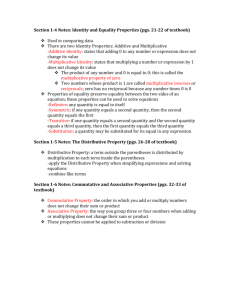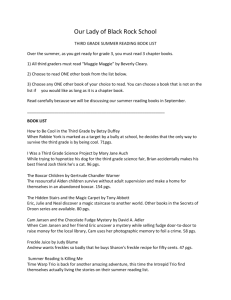Grade 8 Unit 3 Science Curriculum Map
advertisement
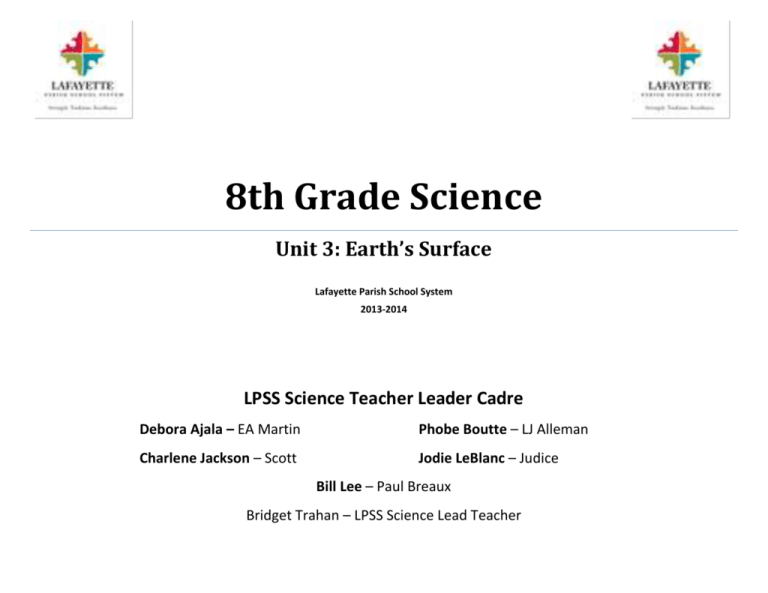
8th Grade Science Unit 3: Earth’s Surface Lafayette Parish School System 2013-2014 LPSS Science Teacher Leader Cadre Debora Ajala – EA Martin Phobe Boutte – LJ Alleman Charlene Jackson – Scott Jodie LeBlanc – Judice Bill Lee – Paul Breaux Bridget Trahan – LPSS Science Lead Teacher Lafayette Parish School System 2013-2014 Curriculum Map Grade: 8th Science Unit 3: Earth’s Surface Time Frame: November 12 – December 20 (5 Weeks) Unit Description and Student Understandings: This unit focuses on human actions and natural processes that shape the landforms of Louisiana, with explanations of how weathering and erosion agents affect Earth’s surface. Reading topographical maps and the topography of the continents and ocean floor are also addressed. Students should understand that the landforms and coastal areas of Louisiana present evidence of natural processes as well as the influences of human actions. Students learn that both mechanical and chemical weathering account for significant changes on Earth’s surface. Students develop an understanding of the role of organic processes in soil formation and the relationship between plant types and soil compatibility of soil. They should understand the concept of relief by using and creating topographical maps. Students will compare and contrast ocean floor features to those found on the continents. This unit focuses on human activities that affect Earth’s systems and resources, such as point source and non-point source pollution. The importance of clean water and factors that would be considered methods of protecting water resources are also addressed in this unit. Students will be able to describe the effects of soil composition on plant growth. The students will understand that natural and human-induced pollution serves as a major threat to our water and air. Local issues provide motivation for an investigation of pollutants, and students will learn to focus on issues related to the quality of life, and the degradation of habitats. Guiding Questions: 1. 2. 3. 4. 5. 6. 7. 8. 9. 10. 11. Can students describe the forces that have formed and shaped Louisiana? Can students describe factors that have impacted Louisiana’s coastal region? Can students describe erosion processes and their agents? Can students describe weathering processes and their agents? Can students explain how soil is formed? Can students interpret contour lines and topographic profiles? Can students describe the importance of soil compatibility and plant type as it relates to Louisiana crops and vegetation? Can students identify point and non-point sources of pollution? Can students distinguish among several effects of water erosion and preventative measures? Can students articulate the importance of conserving water? Can students analyze the effects of human activities on the environment? Key Concepts: Identify characteristics of major landforms and determine the effects of constructive or destructive forces on them (mountains, valleys, river systems, plateaus, and plains) Identify effective measures for the prevention of soil and coastal erosion Identify roles, types, and agents of weathering and erosion, including coastal erosion Describe the components of soil and explain the significance of the presence of organic materials and soil layers Identify major sources of pollution, describe their likely effects, and classify them as point or non-point sources Analyze and identify the impact of human activities and technology on populations, habitats, and Earth systems Vocabulary: Interactive Science textbook CH 8 Lessons 1, 3 pg. 285 Interactive Science textbook CH 9 Lessons 1-3 pg. 313 Interactive Science textbook CH 10 Lessons 1, 2, 4, and 6 pg. 343 Interactive Science textbook CH 11 Lessons 2 pg. 395 Interactive Science textbook CH 19 pg. 655 8th Grade Science 2013-2014 Lafayette Parish School System 2013-2014 Curriculum Map Grade: 8th Science Unit 3: Earth’s Surface Time Frame: November 12 – December 20 (5 Weeks) GLEs CCSS Literacy Standards NGSS Practices Instructional Strategies Probe: Beach Sand ES-19 (I) Determine the results of constructive and destructive forces upon landform development with the aid of geologic maps of Louisiana (ESS-M-A7) ES-20 (I) Describe how humans’ actions and natural processes have modified coastal regions in Louisiana and other locations (ESS-M-A8) SE-53 (C) Distinguish among several examples of erosion (e.g., stream bank, topsoil, coastal) and describe common preventative measures (SE-MA10) ES-14 (E) 8th Grade Science 2013-2014 Interactive Science Textbook: Chapter 8 Lesson 1 pgs. 282-291 Chapter 9 Lesson 1 pgs. 314-321 Chapter 10 Lesson 1 pgs. 344-347 Chapter 10 Lesson 2 pgs. 351-357 LCC Activity 1: Shaping the Land: Constructive and Destructive forces (3 days) - Part A: Video: Hurricane on the Bayou - Part C,D: Teacher Demo - http://www.nola.com/speced/lastchance/multimedia /flash.ssf?flashlandloss1.swf Video: The Rise and Disappearance of SW LA – how it evolved, devolved and human impact upon the coastline. United Streaming (Discovery Education) – Landforms and Living Patterns (SRCD) Louisiana Geological Map Also Addresses GLE’s 20, 28 and 53 Interactive Science textbook: Chapter 10 Lesson 4 pgs. 364-367 Chapter 10 Lesson 6 pgs. 372-377 LCC Activity 2: Water Impact Also Addresses GLE’s 19, 51 Interactive Science Textbook: Chapter 9 Lesson 3 pg. 333 Chapter 10 Lesson 1 pgs. 344-347 Chapter 10 Lesson 2 pgs. 348-357 Chapter 10 Lesson 4 pgs. 364-367 Chapter 10 Lesson 6 pgs. 376-377 Addressed in LCC Activity 1 LCC Activity 4: Erosion Prevention Interactive Science Textbook: Chapter 9 Lesson 1 pgs. 310-321 Differentiation (Enrichment/Remediation Strategies) Lafayette Parish School System 2013-2014 Curriculum Map Grade: 8th Science Unit 3: Earth’s Surface Time Frame: November 12 – December 20 (5 Weeks) Distinguish between chemical and mechanical (physical) weathering and identify the role of weathering agents (e.g., wind, water, ice, gravity) (ESSM-A4) SE-51 (I) Analyze the consequences of human activities on global Earth systems (SE-M-A4) ES-15 (E) Illustrate the role of organic processes in soil formation (ESS-M-A4) SE-52 (C) Describe the relationship between plant type and soil compatibility (SE-M-A9) ES-21 (I) Read and interpret topographic maps (ESS-M-A9) ES-22 (E) Compare ocean floor topography to continental topography by using 8th Grade Science 2013-2014 Chapter 10 Lesson 1 pgs. 346-347 LCC Activity 4: Whether it Weathers-Chemically? LCC Activity 5: Whether or Not (2 days) - Part A: Literacy Strategy – Vocabulary cards along with class discussion - Part B: Previously covered in Activity 4 - Part C: Literacy Strategy – Learning Log Examples of erosion and deposition Also Addresses GLE’s: 51, 53 Interactive Science Textbook: Chapter 10 Lesson 6 pgs. 372-382 Addressed in LCC Activities 2 and 5 Interactive Science Textbook: Chapter 9 Lesson 2 pgs. 322-329 LCC Activity 6: Soil Characteristics - Part A & B Substitute “Soil Scenario” based on the Soil Science Education homepage - Part C: Substitute “Soil Safari” from Discovery Education Addresses GLE 52 Interactive Science Textbook: Chapter 9 Lesson 2 pgs. 326-327 Chapter 9 Lesson 3 pgs.330-333 Addressed in LCC Activity 6 LCC Activity 1: Soil Sleuths Interactive Science Textbook: Chapter 8 Lesson 3 pgs. 292-299 LCC Activity 7: Ooh, What a Relief It Is (3 days) - Part A and B: substitute “Using a Topographic Map” from Prentice Hall Resource Pro - Class discussion of Topographic Maps Topographic Map Activity (2 days) Interactive Science Textbook: Chapter 11 Lesson 2 pgs. 398-399 LCC Activity 8: Ocean Floor (3 days) - Literacy Strategy: KWL Chart Graph of ocean floor and comparison to dry land features Lafayette Parish School System 2013-2014 Curriculum Map Grade: 8th Science Unit 3: Earth’s Surface Time Frame: November 12 – December 20 (5 Weeks) topographic maps (ESS-M-A9) SE50 (E) Illustrate possible point and non-point source contributions to pollution and natural or human-induced pathways of a pollutant in an ecosystem (SEM-A3) SE51 (E) Analyze the consequences of human activities on global Earth systems (SE-M-A4) Probe: Dead Zone Interactive Science Textbook: Chapter 19 Lesson 1 pgs. 656-661 Chapter 19 Lesson 2 pgs. 662-669 LCC Activity 2: Where Does the Water Run? www.scorecard.org www.epa.gov/tri/ LCC Activity 3: Campus Pollution Patrol **Schedule Lafayette Consolidated Government Department of Environmental Quality guest speakers. The presentation uses the Enviroscape Model and addresses GLE’s 50 and 51 Interactive Science Textbook: Chapter 19 Lesson 3 pgs. 670-677 Chapter 19 Lesson 4 pgs. 678-683 (Lesson 3 done in Unit 5 for climate, but revisit to relate climate change and pollution) LCC Activity 5: Every Drop Counts (2 Days) Part A: A Drop in the Bucket http://extension.usu.edu/waterquality/files/uploads/PDF/A%20drop %20in%20the%20bucket.pdf Part B: Water Conservation Literacy Strategy: Learning Log Prompt: What would happen if greater and greater volumes of our drinkable water became polluted? & What are some things that I can do to personally conserve the amount of water I use? United Streaming: “Sources of Life: Water in Our Environment” LCC Activity 6: Can We Fix It? (4 Days) Part A: Assign student groups research on potential environmental problems in Louisiana. Groups should produce a newsletter about the problem and possible solutions. Part B: Presentation to class. UNIT 3 BENCHMARK ASSESSMENT 8th Grade Science 2013-2014 Environmental Hazards: Louisiana DECEMBER 20 www.deq.louisiana.gov/portal/ Personal Water Usage http://ga.water.usgs.gov/edu/sq3.html Natural Resources & Christmas Trees http://www.mii.org/pdfs/have/EverythingWe Have.pdf pgs 22 & 23

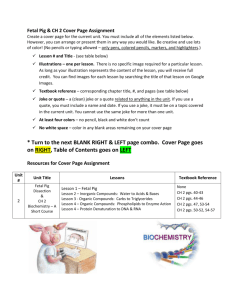
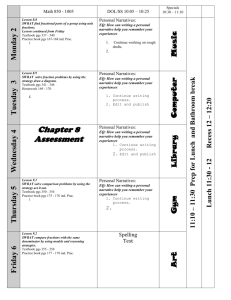
![Introduction [max 1 pg]](http://s3.studylib.net/store/data/007168054_1-d63441680c3a2b0b41ae7f89ed2aefb8-300x300.png)

